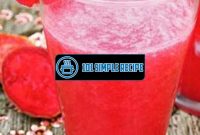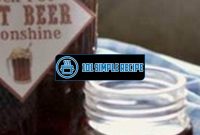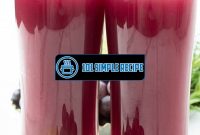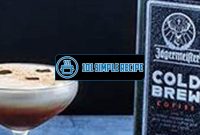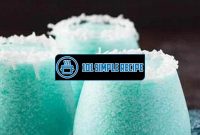Are you a fan of refreshing homemade beverages? Look no further! Today, we bring you a tantalizing recipe for delicious elderflower cordial without citric acid. Whether you’re planning a summer barbecue or simply want to quench your thirst on a warm day, this cordial is the perfect choice. Made from fragrant elderflower blossoms, this beverage offers a delightful combination of sweet and floral flavors that will leave your taste buds craving for more. Wave goodbye to artificial ingredients and say hello to a natural and invigorating drink that will become a staple in your home. Get ready to learn the secrets behind this delightful recipe and prepare to impress your friends and family. Cheers to a sensational elderflower cordial that will elevate your summer gatherings!

Understanding Elderflower Cordial
Discover the delightful and refreshing elderflower cordial, a popular drink made from elderflowers without the use of citric acid.
What is Elderflower Cordial
Elderflower cordial is a sweet and fragrant syrup that is commonly made from elderflowers. It is a popular beverage, especially during the summer months.
The cordial is typically made by combining elderflowers with sugar, water, and sometimes other flavorings such as lemon or orange zest. The mixture is then simmered for a period of time to extract the flavors and create a syrupy consistency.
Elderflower cordial is known for its floral and slightly citrusy taste, making it a refreshing and flavorful drink. Its versatility allows it to be enjoyed on its own, mixed with water or sparkling water, or even used as a cocktail mixer.
Benefits of Making Elderflower Cordial without Citric Acid
Making elderflower cordial without citric acid offers several benefits. Citric acid is commonly used as a preservative in many commercial cordials, but some individuals may be sensitive or allergic to it.
By avoiding citric acid, you can create a cordial that is suitable for those with dietary restrictions or preferences. Additionally, making your own cordial allows you to control the ingredients and avoid any artificial additives or excessive sugar content.
Elderflower cordial is also a great way to enjoy the health benefits of elderflowers. Elderflowers are known to have antioxidant and anti-inflammatory properties, as well as potential immune-boosting effects. By making your own cordial, you can ensure that you’re getting the full benefits of the elderflowers.
Harvesting Elderflowers for Cordial
Harvesting elderflowers for cordial is an enjoyable and rewarding process. Elderflowers are typically in bloom during the late spring and early summer months, making it the perfect time to gather them.
When harvesting elderflowers, it’s important to choose flowers that are fully open and have a strong fragrance. Avoid flowers that are wilted or have turned brown. It’s also recommended to harvest the flowers in the morning when their scent is at its strongest.
To harvest the flowers, gently cut the heads with a pair of clean scissors or shears. Be careful not to damage the neighboring flowers or branches.
Once you have gathered the elderflowers, it’s important to use them as soon as possible to maintain their freshness and flavor. They can be stored in the refrigerator for a short period of time, but it’s best to use them within a day or two.
Note: Harvesting elderflowers for cordial can be a fun activity to do with friends or family. Take the opportunity to enjoy nature and create a delicious drink at the same time.
Overall, understanding elderflower cordial and its various aspects, from its preparation to its benefits and harvesting process, allows you to appreciate this delightful beverage even more. So go ahead, try making your own elderflower cordial without citric acid and savor its refreshing taste.
Craving something sweet? Try this delicious peanut butter cup recipe that combines the flavors of chocolate and peanut butter in a delightful treat.
Ingredients for Elderflower Cordial without Citric Acid
Explore the essential ingredients needed to create a delicious elderflower cordial without citric acid.
Elderflowers
Elderflowers are the star ingredient in this delightful cordial. These small, fragrant flowers are rich in flavor and lend a unique taste to the recipe. You’ll need a good quantity of fresh elderflowers to infuse the cordial and capture their essence.
Elderflowers have a distinct floral aroma with hints of citrus and honey. They are typically picked during the spring when they are in full bloom. Make sure to select fresh elderflowers that are free from any browning or wilting.
To prepare the elderflowers, gently shake them to remove any bugs or debris. Avoid washing the flowers as this can diminish their flavor. Instead, rely on inspecting the flowers individually and plucking off any unwanted stems or leaves.
Sugar and Alternative Sweeteners
To create a delicious elderflower cordial without citric acid, you’ll need a sweetener to balance the floral flavors. Traditional recipes use white sugar, but you can explore alternative sweeteners as well.
White sugar provides a clean and neutral sweetness that allows the elderflower flavors to shine. However, if you prefer a healthier option or have dietary restrictions, you can try using honey, agave syrup, or stevia. Each sweetener will impart its own unique taste, so adjust the quantities accordingly to achieve your desired level of sweetness.
When using honey or agave syrup, opt for lighter varieties to avoid overpowering the delicate elderflower flavor. Stevia can be used in smaller amounts as it is much sweeter than sugar. Keep tasting the cordial as you add the sweetener to ensure it’s perfectly balanced. ️
Flavor Enhancers
While elderflowers pack a punch of flavor on their own, you can enhance the cordial by adding a few additional ingredients. These flavor enhancers will elevate the taste and make your elderflower cordial truly exceptional.
One popular option is to add sliced lemons or lemon zest for a citrusy twist. Lemons complement the elderflower’s natural citrus notes and brighten the overall flavor. You can also experiment with other fruits such as oranges or limes to add a different dimension to the cordial.
Another option is to incorporate herbs like mint or thyme. These herbs bring a refreshing and herbal undertone to the cordial, adding complexity to the taste. Consider adding a sprig or two during the infusion process and remove them once the flavors have melded together.
Lastly, don’t forget about the power of spices. A touch of cinnamon or ginger can add warmth and depth to the elderflower cordial. Experiment with small amounts and adjust to your liking, keeping in mind that the flavor will intensify over time as the cordial matures.
With these essential ingredients, you are well on your way to creating a delicious elderflower cordial without citric acid. Get creative, personalize the recipe to your taste, and enjoy the refreshing flavors of this delightful drink. Cheers!
Step-by-Step Guide to Making Elderflower Cordial without Citric Acid
Follow these detailed instructions to create your own batch of elderflower cordial without citric acid, bursting with flavor and natural goodness.
Preparing the Elderflowers
Before you start making your elderflower cordial, it is important to properly prepare the elderflowers. Here’s what you need to do:
- Gather Fresh Elderflowers: Go out and pick fresh elderflowers when they are in full bloom. Look for flowers with a strong fragrance and bright white petals.
- Inspect the Flowers: Carefully examine the elderflowers and remove any bugs or debris.
- Remove the Stems: Pluck the flowers from the stems, ensuring you have only the blossoms.
- Wash the Flowers: Give the flowers a gentle rinse to wash away any dirt or pollen.
Making the Elderflower Cordial
Now that the elderflowers are prepared, it’s time to make the delicious cordial. Here are the steps to follow:
- Ingredients: Gather the following ingredients:
- Fresh elderflowers (prepared)
- Sugar
- Lemon zest
- Lemon juice
- Water
- Create a Syrup: In a large saucepan, combine the sugar, lemon zest, lemon juice, and water. Bring the mixture to a simmer, stirring until the sugar is fully dissolved.
- Add the Elderflowers: Carefully place the prepared elderflowers into the saucepan with the syrup. Stir gently to make sure the flowers are fully coated.
- Infuse: Cover the saucepan and let the elderflowers steep in the syrup for around 24-48 hours, allowing the flavors to meld together.
- Strain the Mixture: After the steeping period, strain the mixture through a fine-mesh sieve or cheesecloth to remove the elderflowers and any sediment.
- Bottle the Cordial: Pour the strained elderflower cordial into sterilized glass bottles or jars. Make sure to seal the containers tightly.
Storing and Serving the Elderflower Cordial
Now that your elderflower cordial is ready, it’s important to store and serve it properly. Follow these steps:
- Storage: Store the bottles of elderflower cordial in a cool, dark place. It will keep well for several months.
- Serving: To serve, mix the elderflower cordial with sparkling water or still water, depending on your preference. Add ice and a garnish, such as a slice of lemon or a sprig of mint, for an extra refreshing touch.
Note: There are many variations of elderflower cordial recipes, but this version without citric acid offers a natural and delicious alternative. The absence of citric acid allows the floral flavors of the elderflowers to shine through, creating a refreshing and fragrant drink.
By following these step-by-step instructions, you can create your own batch of elderflower cordial without citric acid. Enjoy the process and savor the delightful flavors of this homemade beverage!
If you’re looking for more refreshing beverage recipes, check out this punch bowl recipe that’s perfect for parties and gatherings.
Alternative Uses for Elderflower Cordial
Discover creative ways to use your homemade elderflower cordial in various recipes and beverages, adding a touch of floral essence to your culinary creations.
Refreshing Summer Drinks
When the weather gets hot, there’s nothing more refreshing than a cool and flavorful drink. Your homemade elderflower cordial can be a star ingredient in a variety of summer beverages. One popular option is to mix it with sparkling water for a refreshing elderflower spritzer. The floral notes of the cordial give a unique twist to the classic spritzer, making it a delightful choice for hot summer days.
Another way to enjoy your elderflower cordial is by making a fruity punch. Just combine the cordial with your favorite fruit juices, add some ice, and you’ll have a delicious and refreshing beverage that will be a hit at any summer gathering.
If you prefer a more tropical flavor, you can use your elderflower cordial to make a delightful elderflower mojito. Simply muddle some fresh mint leaves, add some lime juice, a splash of rum, and of course, your elderflower cordial. Top it off with club soda and you’ll have a light and refreshing cocktail that’s perfect for lounging by the pool.
Delicious Desserts
Aside from being a great addition to summer drinks, elderflower cordial can also enhance the flavor of your favorite desserts. One simple yet delicious idea is to drizzle the cordial over a scoop of vanilla ice cream. The floral sweetness of the cordial pairs beautifully with the creamy ice cream, creating a truly indulgent treat.
If you enjoy baking, you can incorporate your elderflower cordial into various dessert recipes. For instance, you can add a splash of cordial to your favorite cake batter to infuse it with a delicate floral flavor. You can also use the cordial in the frosting or glaze to add a subtle hint of elderflower to your cakes, cookies, or pastries.
Cocktails and Mocktails
Whether you’re hosting a party or simply want to enjoy a refreshing drink at the end of a long day, elderflower cordial can elevate your cocktail or mocktail game. For a sophisticated and elegant option, mix your cordial with prosecco or champagne for a delightful elderflower fizz. The bubbles from the sparkling wine complement the floral sweetness of the cordial, creating a drink that’s perfect for celebrations.
If you prefer non-alcoholic options, you can use your elderflower cordial to create refreshing mocktails. Combine it with lemonade, soda water, and a squeeze of lime to make a zesty elderflower mocktail. Garnish it with a sprig of fresh mint or a slice of cucumber for an extra touch of freshness.
With its delicate floral flavor, homemade elderflower cordial is a versatile ingredient that can be used in a variety of recipes and beverages. Get creative and explore the possibilities of adding a touch of floral essence to your culinary creations. Whether you’re sipping on a refreshing summer drink, indulging in a delicious dessert, or enjoying a cocktail/mocktail, elderflower cordial is sure to elevate your experience.
Troubleshooting Tips and Common Mistakes
Addressing potential challenges and mistakes in making elderflower cordial without citric acid, ensuring a successful and enjoyable experience.
Preventing Spoilage
When making elderflower cordial without citric acid, it is important to take precautions to prevent spoilage. Spoilage can occur due to improper storage or contamination during the preparation process. Here are some tips to help prevent spoilage:
- Use sterilized bottles or jars to store the cordial. This will help prevent the growth of harmful bacteria and extend the shelf life of the cordial.
- Ensure that the elderflowers are fresh and free from any mold or decay. Discard any flowers that have turned brown or have a foul smell. It is best to pick the flowers in the morning when they are at their freshest.
- Keep the cordial refrigerated at all times to slow down the growth of bacteria and yeast. This will help maintain the quality and flavor of the cordial. ❄️
- Avoid exposing the cordial to sunlight or heat, as this can accelerate spoilage. Store the cordial in a cool, dark place to maintain its freshness. ️
Note: If you notice any signs of spoilage, such as a cloudy appearance, unusual odor, or off taste, it is best to discard the cordial to prevent any potential health risks.
Adjustments for Personal Preference
While the elderflower cordial recipe without citric acid provides a delicious and refreshing flavor, you may want to make adjustments to suit your personal preference. Here are some ideas to customize your cordial:
- Sweetness: If you prefer a sweeter cordial, you can increase the amount of sugar in the recipe. However, be cautious not to add too much sugar, as it can overpower the delicate elderflower flavor.
- Flavor Infusions: You can experiment with different flavor infusions to enhance the taste of your cordial. Add a few slices of lemon or lime for a citrusy twist, or try adding a couple of fresh mint leaves for a refreshing touch.
- Fizz: If you enjoy carbonated drinks, you can add a splash of carbonated water to your cordial for a sparkling effect. This can make your cordial more vibrant and festive.
Potential Substitutions and Variations
While the elderflower cordial recipe without citric acid is delicious as it is, there are some potential substitutions and variations you can try to add a unique twist to your cordial:
| Ingredient | Potential Substitution |
|---|---|
| Sugar | Honey or maple syrup for a natural sweetener. |
| Lemon | Orange or grapefruit for a different citrus flavor. |
| Water | Sparkling water for a fizzy elderflower cordial. |
Feel free to experiment with different substitutions and variations to create a cordial that suits your taste preferences. Remember to adjust the quantities accordingly to maintain the balance of flavors.
If you’re a fan of homemade sauces, you’ll love this ranch oyster crackers recipe that’s perfect for snacking or adding a crunchy element to soups and salads.
Thank you for taking the time to read our article on how to make elderflower cordial without citric acid. We hope you found the recipe and tips helpful in creating your own delicious homemade cordial. Remember, elderflower cordial is a refreshing and versatile drink that can be enjoyed on its own or used as a base for cocktails and desserts. If you have any questions or feedback, please feel free to leave a comment below. We appreciate your support and encourage you to visit our website again for more exciting recipes and culinary inspiration. Cheers!
Frequently Asked Questions
Here are some frequently asked questions about elderflower cordial:
| No. | Questions | Answers |
|---|---|---|
| 1. | Can I substitute lemon juice for citric acid in elderflower cordial? | Yes, you can use lemon juice as a natural alternative to citric acid in elderflower cordial. Simply replace the citric acid with an equal amount of freshly squeezed lemon juice. |
| 2. | How long does elderflower cordial last? | When stored in a sterilized bottle in the refrigerator, elderflower cordial can last for up to 2 months. It’s important to check for any signs of spoilage, such as a strange odor or cloudiness, before consuming. |
| 3. | Can I freeze elderflower cordial? | Yes, you can freeze elderflower cordial in ice cube trays or airtight containers. This allows you to enjoy the cordial for a longer period of time and easily portion it for future use. |
| 4. | What are some variations of elderflower cordial? | You can experiment with different flavor combinations by adding ingredients such as mint leaves, ginger, or berries to your elderflower cordial. This allows you to customize the taste and create unique variations. |
| 5. | Can I use dried elderflowers for cordial? | Yes, you can use dried elderflowers to make cordial. However, fresh elderflowers are recommended for a more vibrant and aromatic flavor. |
| 6. | What are some uses for elderflower cordial? | Elderflower cordial can be used in a variety of ways, such as mixing it with sparkling water for a refreshing drink, adding it to cocktails for a floral twist, or using it as a flavoring in desserts and baked goods. |
Jump to Recipe
Elderflower Cordial Without Citric Acid

Learn how to make elderflower cordial without citric acid with this easy step-by-step recipe. Enjoy the refreshing taste of elderflower in this homemade cordial.
- 20 fresh elderflower heads
- 1.5 kg white sugar
- 1.5 liters water
- 2 lemons (zested and juiced)
- 1 teaspoon tartaric acid (optional)
- 1 teaspoon citric acid (optional)
- Gently shake the elderflower heads to remove any insects. Trim off the thick stems, leaving only the flowers. Rinse the flowers briefly under cold water to remove any dirt or debris.
- In a large saucepan, combine the sugar and water. Heat over medium heat, stirring occasionally, until the sugar has completely dissolved. Add the elderflower heads, lemon zest, and lemon juice to the syrup. If desired, add tartaric acid and citric acid for an extra tangy flavor.
- Cover the saucepan and let the elderflower cordial mixture infuse at room temperature for 24 hours. This allows the flavors to meld together and create a fragrant cordial.
- After 24 hours, strain the elderflower cordial through a fine-mesh sieve or cheesecloth into clean, sterilized bottles. Discard the elderflower heads and lemon zest. Seal the bottles tightly and store the elderflower cordial in the refrigerator for up to 2 months.
- To enjoy your homemade elderflower cordial, simply dilute it with sparkling water or still water according to your taste. Add ice and garnish with a slice of lemon or a sprig of mint, if desired. Cheers!


